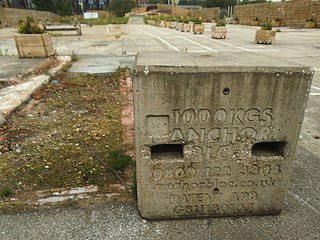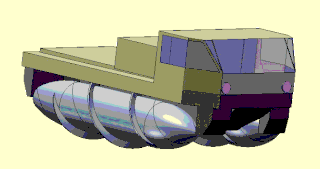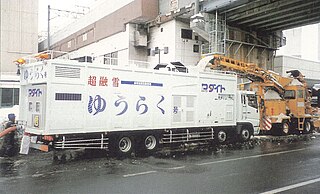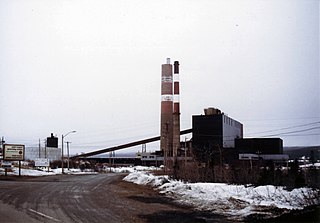
Canada, the world's second-largest country in total area, is dedicated to having an efficient, high-capacity multimodal transport spanning often vast distances between natural resource extraction sites, agricultural and urban areas. Canada's transportation system includes more than 1,400,000 kilometres (870,000 mi) of roads, 10 major international airports, 300 smaller airports, 72,093 km (44,797 mi) of functioning railway track, and more than 300 commercial ports and harbours that provide access to the Pacific, Atlantic and Arctic oceans as well as the Great Lakes and the St. Lawrence Seaway. In 2005, the transportation sector made up 4.2% of Canada's GDP, compared to 3.7% for Canada's mining and oil and gas extraction industries.

The tonne is a metric unit of mass equal to 1,000 kilograms. It is also referred to as a metric ton to distinguish it from the non-metric unit. It is equivalent to approximately 2,204.6 pounds; 1.102 short tons (US), and 0.984 long tons (UK). The official SI unit is the megagram, a less common way to express the same mass.

A snowmobile, also known as a Ski-Doo, snowmachine, sled, motor sled, motor sledge, skimobile, or snow scooter, is a motorized vehicle designed for winter travel and recreation on snow. It is designed to be operated on snow and ice and does not require a road or trail, but most are driven on open terrain or trails. Snowmobiling is a sport that many people have taken on as a serious hobby.

An ice shelf is a large floating platform of ice that forms where a glacier or ice sheet flows down to a coastline and onto the ocean surface. Ice shelves are only found in Antarctica, Greenland, Northern Canada, and the Russian Arctic. The boundary between the floating ice shelf and the anchor ice that feeds it is the grounding line. The thickness of ice shelves can range from about 100 m (330 ft) to 1,000 m (3,300 ft).

Snow removal or snow clearing is the job of removing snow after a snowfall to make travel easier and safer. This is done by both individual households and by governments and institutions.

Bruce Nodwell, was a Canadian inventor who invented the Nodwell 110, a multi-purpose two-tracked vehicle capable of traversing a wide variety of adverse terrain, including sand, mud, muskeg, swamp, and snow.

A screw-propelled vehicle is a land or amphibious vehicle designed to cope with difficult snow and ice or mud and swamp. Such vehicles are distinguished by being moved by the rotation of one or more auger-like cylinders fitted with a helical flange that engages with the medium through or over which the vehicle is moving. Modern vehicles called Amphirols and other similar vehicles have specialised uses.

Waste-to-energy (WtE) or energy-from-waste (EfW) is the process of generating energy in the form of electricity and/or heat from the primary treatment of waste, or the processing of waste into a fuel source. WtE is a form of energy recovery. Most WtE processes generate electricity and/or heat directly through combustion, or produce a combustible fuel commodity, such as methane, methanol, ethanol or synthetic fuels.

A winter service vehicle (WSV), or snow removal vehicle, is a vehicle specially designed or adapted to clear thoroughfares of ice and snow. Winter service vehicles are usually based on a dump truck chassis, with adaptations allowing them to carry specially designed snow removal equipment. Many authorities also use smaller vehicles on sidewalks, footpaths, and cycleways. Road maintenance agencies and contractors in temperate or polar areas often own several winter service vehicles, using them to keep the roads clear of snow and ice and safe for driving during winter. Airports use winter service vehicles to keep both aircraft surfaces, and runways and taxiways free of snow and ice, which, besides endangering aircraft takeoff and landing, can interfere with the aerodynamics of the craft.

The Gibeau Orange Julep restaurant is a roadside attraction and fast food restaurant in Montreal, Quebec, Canada. The building is in the shape of an orange, three stories high, with a diameter of 40 feet (12 m).

A snow melter is a piece of snow removal equipment designed to melt snow using flame burners, hot water or both. The melt-water is discharged into a storm drain or onto the ground. Melting snow artificially helps keep roads, airport tarmacs and other surfaces clear and ready to use, and the technology is primarily employed in areas where trucking snow is not geographically or economically feasible. A built-in snowmelt system which melts the snow where it falls is another snow removal alternative.

William Joseph Still was an English engineer. He was born at Reigate on 17 August 1870. In 1884, he went to Canada to work for a firm of electric vehicle manufacturers. In 1894, he returned to England, where he invented a double-acting diesel-steam engine in which waste heat from the cylinder jacket and the exhaust was used to produce steam to assist the diesel engine. This is covered by U.S. patent 1230617 of 1917. Still also invented the Still heat-transmitting tube which was used in refrigeration plant.

The Point Tupper Generating Station is a 150 MW Canadian electrical generating station located in the community of Point Tupper in Richmond County, Nova Scotia.
Joseph Andrew Lapointe, also known as Andy Lapointe, was a Senior Research Scientist at Domtar Research Centre in Senneville Quebec. He was involved in the development of mechanical processes and equipment at the research level for over 25 years. During his time at Domtar he specialized in the development of chipping technology and has a number of patents and patents pending in his field. He assisted in the development of over 30 sawmills improving the quality of their chips to meet the requirements of specific pulp mills. Prior to joining Domtar, he was with the Pulp and Paper Research Institute of Canada (Paprican) where he co-invented the Papriformer and was involved in its development. This wet sheet former has been the subject of numerous papers and is considered one of the major advances in papermaking technology. The Papriformer received the Governor General's award for Engineering Design in 1975. Lapointe has also been responsible for a number of analytical devices which are in use in universities, research centres and technical laboratories.

Benoît Laliberté is a Canadian entrepreneur and inventor and is currently a Senior Member of Investel Capital Corporation. He is the founder of JITEC, Vectoria Inc., TeliPhone Corp., and the New York Telecom Exchange Inc. Earlier in his career, Laliberté gained some notoriety in Quebec with JITEC, a public company which at its peak in 2000 had an estimated value of $CDN575 million. More recently, he invented several technologies in telecommunications, social media, and information technology (IT).

Mecca Ointment is the product name of a first aid ointment used for the temporary relief of pain and/or itching associated with minor burns, sunburn, minor cuts, scrapes, insect bites and for the temporary protection of minor skin irritations. The formulation contains the medicinal ingredients Phenol 0.5%, Camphor 0.5% and Zinc Oxide 1.25%. Mecca Ointment is currently available for sale in Canada.

Sigurd Johannes Savonius was a Finnish architect and inventor. He is known especially for the Savonius wind turbine, which he invented in 1924.
Shelagh Alexander was a Canadian photographic artist based in Toronto, Ontario, known for her large scale “compilation photographs”.

Outram is an unincorporated community in the Rural Municipality of Cambria#6, Saskatchewan, Canada. It is located at NE Section 19, Township 2, Range 10, W2, just north of highway 18 between Estevan and Torquay, Saskatchewan along the Long Creek Railroad.
CarbonCure Technologies is a manufacturer of carbon removal and utilization technologies that inject captured carbon dioxide into concrete. It was founded in 2012 by Rob Niven, and the company headquarters are in Halifax, Nova Scotia.

















